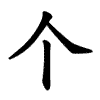个
| ||||||||
Translingual
| Stroke order | |||
|---|---|---|---|
 | |||
Han character
个 (radical 2, 丨+2, 3 strokes, cangjie input 人中 (OL), four-corner 80200, composition ⿱人丨)
References
- KangXi: page 78, character 23
- Dai Kanwa Jiten: character 70
- Dae Jaweon: page 158, character 3
- Hanyu Da Zidian: volume 1, page 103, character 1
- Unihan data for U+4E2A
Chinese
Glyph origin
| Historical forms of the character 个 | ||
|---|---|---|
| Warring States | Shuowen Jiezi (compiled in Han) | Liushutong (compiled in Ming) |
| Bronze inscriptions | Small seal script | Transcribed ancient scripts |
 |
 |
 |
Definitions
| For pronunciation and definitions of 个 – see 個 (“piece; item; individual; size; height; etc.”). (This character, 个, is the simplified and variant traditional form of 個.) |
Notes:
|
Japanese
Korean
This article is issued from
Wiktionary.
The text is licensed under Creative
Commons - Attribution - Sharealike.
Additional terms may apply for the media files.